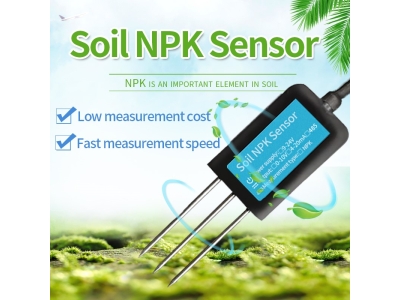Precision agriculture, also known as precision farming or smart farming, is a modern farming management concept that utilizes technology to optimize agricultural practices and increase productivity. One of the key components of precision agriculture is soil sensor data analysis, which allows farmers to make informed decisions based on real-time information about soil conditions. In this article, we will explore the role of soil sensor data analysis in maximizing productivity in agriculture and its potential impact on the future of farming.

Understanding Soil Sensor Data Analysis
Soil sensor data analysis involves the use of sensors to collect information about various soil properties, such as moisture levels, temperature, nutrient content, and pH levels. This data is then analyzed to gain insights into the health and fertility of the soil, allowing farmers to make precise adjustments to their farming practices. By understanding the specific needs of their soil, farmers can optimize the use of resources, minimize waste, and maximize crop yields.
The Advantages of Soil Sensor Data Analysis
One of the primary advantages of soil sensor data analysis is its ability to provide real-time information about soil conditions. Traditional methods of soil analysis, such as manual sampling and laboratory testing, are time-consuming and often provide only a snapshot of the soil's status. In contrast, soil sensors can continuously monitor soil conditions, allowing farmers to make timely and accurate decisions about irrigation, fertilization, and other farming activities.
Another advantage of soil sensor data analysis is its potential to reduce input costs. By precisely targeting the application of water, fertilizers, and other inputs based on actual soil conditions, farmers can avoid over-applying these resources, thereby saving money and minimizing environmental impact. This targeted approach also helps to improve the overall sustainability of agricultural practices.
Maximizing Productivity with Soil Sensor Data Analysis
Soil sensor data analysis plays a crucial role in maximizing productivity in agriculture. By providing farmers with detailed insights into their soil, this technology enables them to optimize their farming practices in several ways:
Precision Irrigation: Soil sensors can provide real-time information about soil moisture levels, allowing farmers to tailor their irrigation practices to the specific needs of their crops. By avoiding both under- and over-watering, farmers can ensure that their crops receive the right amount of water, leading to improved growth and yield.
Efficient Fertilization: Soil sensors can measure nutrient levels in the soil, helping farmers to apply fertilizers more efficiently. By targeting specific areas of the field that require additional nutrients, farmers can optimize the use of fertilizers and minimize waste. This not only reduces costs but also helps to prevent nutrient runoff, which can have detrimental effects on the environment.
Soil Health Management: Soil sensors can provide valuable information about the overall health of the soil, including its pH levels and organic matter content. By monitoring these factors, farmers can take proactive steps to maintain soil fertility and structure, leading to healthier crops and sustained productivity over time.
Crop Monitoring: Soil sensor data analysis can be integrated with other monitoring technologies, such as remote sensing and drones, to provide a comprehensive view of crop health and growth. By combining soil data with information about plant development, farmers can make informed decisions about pest control, disease management, and harvesting times.
The Future of Precision Agriculture
As technology continues to advance, the potential for soil sensor data analysis in precision agriculture is only expected to grow. Innovations in sensor technology, data analytics, and artificial intelligence are likely to further enhance the capabilities of soil sensors, making them even more valuable tools for farmers.
Furthermore, the integration of soil sensor data analysis with other agricultural technologies, such as autonomous machinery and robotics, holds the promise of creating fully automated, data-driven farming systems. These systems have the potential to revolutionize the way food is produced, making agriculture more efficient, sustainable, and resilient in the face of environmental challenges.
Conclusion
Soil sensor data analysis is a cornerstone of precision agriculture, offering farmers the ability to make informed, data-driven decisions that maximize productivity while minimizing environmental impact. By harnessing the power of soil sensors, farmers can optimize their use of resources, improve crop yields, and ensure the long-term sustainability of their farming practices. As technology continues to evolve, the role of soil sensor data analysis in agriculture is poised to become even more significant, shaping the future of farming and food production.
In conclusion, soil sensor data analysis is a powerful tool that is GPT-3.5 revolutionizing agriculture, and its potential to maximize productivity and sustainability is truly remarkable.





